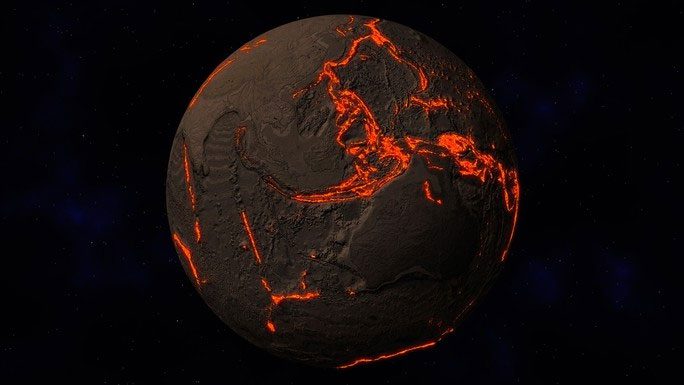3.2 billion years ago, a solid spherical planet with a nearly smooth surface began to crack and break apart into many pieces, mixing external and internal materials. This event paved the way for our existence.
This is precisely what happened to ancient Earth, as demonstrated by a groundbreaking study led by geodynamicist Zheng Xiang Li from Curtin University in Australia.
In 2020, Dr. Li’s team reported on the chemical composition changes of rocks formed in the Earth’s mantle 3.2 billion years ago, suggesting that a planetary-scale mixing had occurred.

Earth 3.2 billion years ago – (Graphic image from LIVE SCIENCE).
Recently, published in Science Direct, they reported finding evidence of this through a “treasure” unearthed in lead-zinc mines in Australia.
The U-Th-Pb System, which refers to the isotopes of uranium, thorium, and lead, is one of the most recognized “geological clocks” by the scientific community.
The mines in Australia helped them determine that our planet was “turned upside down” during that time, causing the ratios of isotopes to differ from materials found in the early Solar System, as seen in the carbonaceous chondrites that we occasionally discover.
All of this recounts a critically important milestone in Earth’s history: From a solid, quiet sphere like Venus or Mars, it began tectonic plate activity 3.2 billion years ago when the planet was only 1.3 billion years old.
As it reached the “critical point”, the early tectonic activity was extremely intense, causing the materials above and within Earth to mix vigorously.
Today, Earth is still tectonically active. The planet’s crust is actually composed of nearly 20 large and small pieces that are “temporarily arranged,” constantly moving, with each piece carrying oceans or continents. This is why, throughout the planet’s history, continents have repeatedly merged into supercontinents and then separated as they are today.
This tectonic process is crucial for us as it provides the driving force for biochemical reactions that form early life; it also helps maintain a planet with an atmosphere, lithosphere, and a stable environment for life to persist and evolve.
The significant milestone that Australian scientists found – 3.2 billion years – also corresponds with some evidence of when early life truly existed in the form of an organism.
Therefore, it can be said that scientists have uncovered a highly important “lost chapter” of our planet.


















































